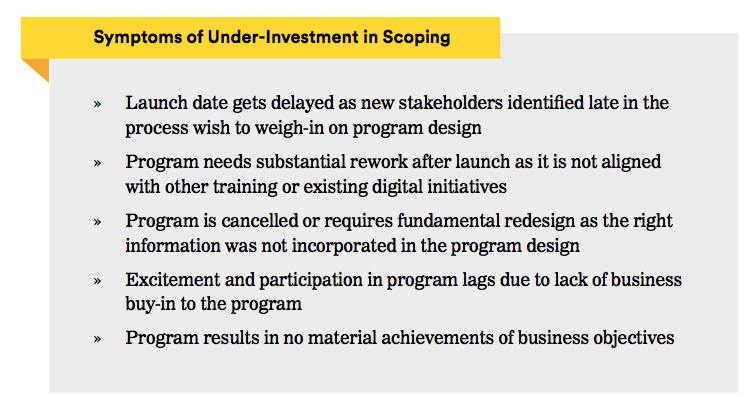The scoping and planning phase is an incredibly important but frequently overlooked element when developing a digital training or transformation program. L&D executives and training sponsors are often bombarded with feedback, including questions, opinions, and pressure to quickly move on launching a solution, which can often lead insufficient planning.
In hearing from large organizations across the globe, GA’s corporate training team has found that an underinvestment in scoping corporate training programs can result in substantial rework, delayed launch dates, and disappointing program outcomes due to prevalent knowledge gaps.

Before moving into the instructional design of any given training program, training executives should ask themselves the following 10 high-level scoping questions to ensure their training materials are aligned with their audience, company’s broader goals, and other training initiatives. Effectiveness is key to building the competency of a new learner.
1. What is the objective of the program?
Getting consensus around a well defined program objective may be time consuming, but will be critical to reducing rework and delays in the instructional design phase. When answering this important question, be as descriptive as possible. Avoid being broad and call out very specific objectives of the employee training experience. (“We want to improve our ability to measure and maximize the ROI of digital campaigns by equipping our marketing team with a strong understanding of the KPIs of each social platform” vs. “We want to win in social.”)
2. What is the organizational context which is driving the need for the program?
Having a clear, consistent articulation of why this training content is important, and why now, will help guide the tone of the program, and will be an important focus of your initial communication plan to your team.
3. What will be the impact on our customers if this program is successful?
Outlining customer-related examples and objectives will provide a clear vision for the results and outcomes the employee training program will ultimately yield.
4. What will be the impact on our organization and our employees if this program is successful? How will we measure for competency?
Measuring near term impact of training programs is challenging. Getting clear up front about how success will be measured will help you make decisions about pilot rollouts, identify when the program needs to be adapted, and will allow you to proactively address questions about training and feedback about ROI and impact.
5. How does this training process align with the company’s business objectives and strategy?
Identifying training’s role within broader business objectives will reinforce buy-in from various stakeholders and will empower participants to reach personal and organizational goals.
6. Who are the key stakeholders that need to be involved? How will they work together?
Addressing the needs and roles of all necessary stakeholders upfront is critical to avoid reworking program design and pushing back the delivery date of each training session. By incorporating each stakeholder’s input, you can ensure your program is aligned with existing digital and training initiatives.
7. Which broad audience should this transformation focus on?
Identifying which high-level audience will have the largest impact on your organization’s transformation will help identify the specific teams and stakeholders that should be included in your training plan and initiative. Identifying specific participants without addressing the high-level audience involved in your transformation can lead to reworking of program design to fit broader objectives.
8. What other initiatives or learning programs need to be considered when designing and delivering this program?
To avoid apparent knowledge gaps, synchronization across existing programs and initiatives is critical to avoid redundancy and/or contradiction for the new learner. Programs that account for existing initiatives will help build buy-in across stakeholders, provide consistent messaging to training participants, and reinforce your organization’s goals.
9. What is the desired timing and sequencing of the transformation?
Defining the timeframe of your organization’s transformation will help identify an appropriate delivery date for your training program. To avoid clashing initiatives, it is important that new learnings and objectives that your training program produces fit into the broader timeframe of your organization’s transformation.
10. How many resources and what budget can be committed to this training process? What is the process for budgetary and resource approval?
Getting a clear picture of your budget is critical for defining your program’s participants, external training partners, and internal resources that will inform the curriculum. Additionally, preemptively exploring processes for budget approval is necessary to ensure that the necessary time is allotted leading up to your desired delivery date.
Specific and descriptive answers to each of these questions will equip training sponsors with the proper context and information going into the design phase of their programs. Contact us today to get tailored recommendations for your workforce transformation.